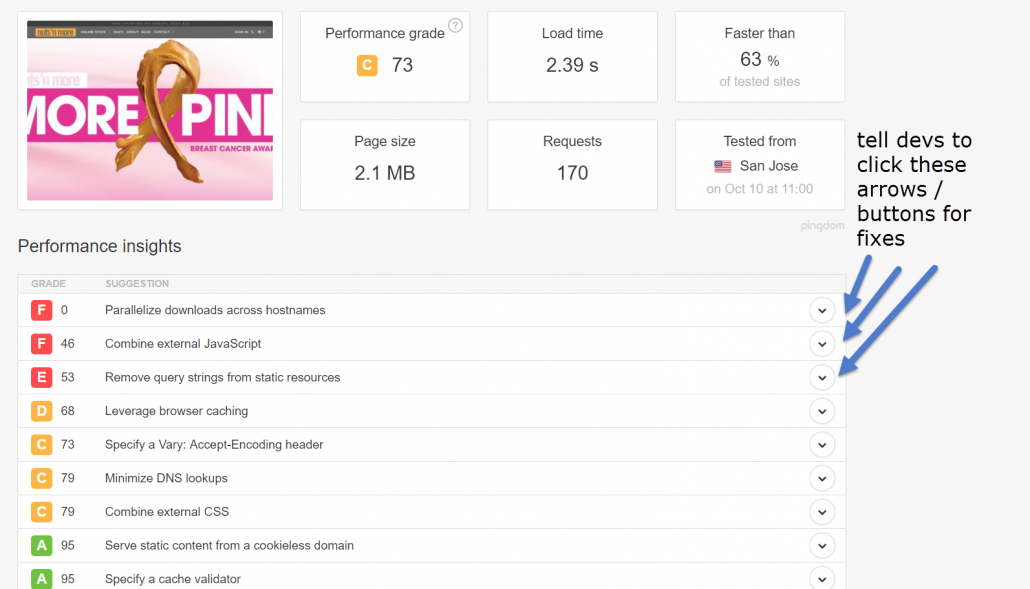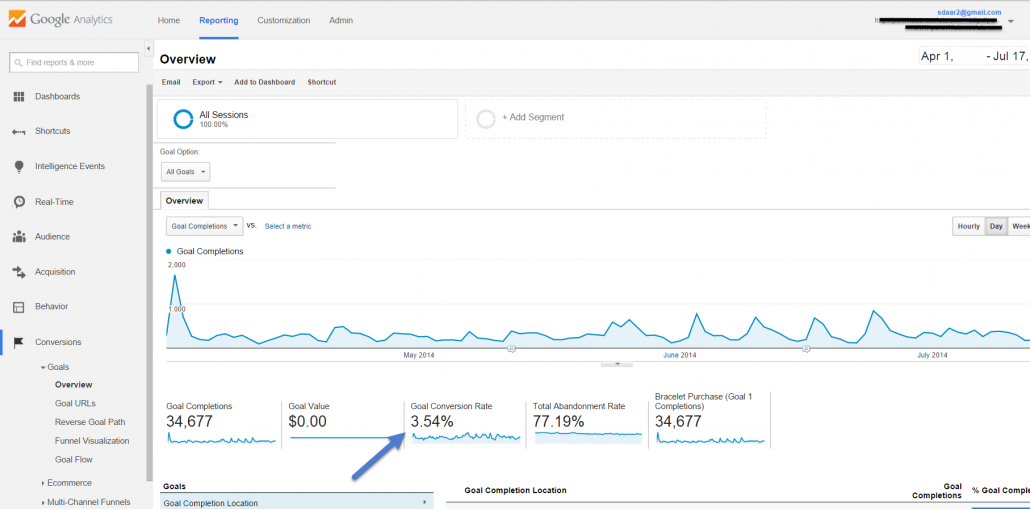Want to Maximize The Profits Your Shopify Store Earns This Coming Holiday Season? Do These 3 Easy Things Today…
Hard to believe we’re already in the 4th quarter of 2017….
It is now crunch time for us to set our Shopify stores up for maximal success this coming holiday season.
Here are 3 things that are easy to do and will positively impact your sales (both during the holidays and beyond!)
Slow Speed Kills: How to Improve Your Shopify Store’s Load Speed
Site speed has become more and more important….both to your site’s conversion rate + bounce rate as well as to Google’s ranking algorithm.
People have grown less patient with sites that do not load quickly.
Google has learned through all the data they collect just how much their users dislike being sent to slow loading sites by their search results.
In the past few algorithm updates, Google has made it so that site speed significantly affects a site’s ranking in search results.
The Site Speed Quick Fix (That Cost Me $1,500 to Learn….)
A little while back, there was a guy who was introduced to me as a “Site Speed Wizard”.
He had some impressive results to back it up so I hired him for $1,500.
A couple days later, he was back with a list of fixes that should be made on the site. I agreed and he went to work making the changes.
It took a couple more days for him to make the changes and in that time, I happened to learn about two new tools for analyzing your site’s speed.
After looking my site up on these tools, I saw nearly the exact same recommendations the “Wizard” was currently implementing!
I asked him if these were the tools he uses to help perform his service and he was honest in admitting they were exactly what he uses for his clients!
And even though the tools he used are free, I was happy to pay him.
He executed quickly + professionally & the results speak for themselves:
Not only does my site now score better on site speed tests, more importantly my bounce rate has decreased and the speed improvement boosted my site from the 2nd & 3rd pages to now ranking on the first page of both Google and Bing for some of my most important search terms.
But enough about me, let’s get the same improved site speed results for you!
The two tools are Pingdom and GTmetrix and they are incredibly easy to use.
Those above links take you to the home pages for the tools and they look like this:
Pingdom:

GTmetrix:

Enter your URL in the box on the page and click the ‘Start Test’ or ‘Analyze’ button. Within 30 seconds you will get a report on that URL’s speed.
note: you can use these tools to analyze any + every page of your website if you would like. I recommend analyzing at least:
– your home page
– a few of your highest trafficked product pages
– your cart page
Don’t Sweat Bad Grades On Your Speed Tests – – Focus On Improvement Today
Beware that GTmetrix almost always gives a worse grade and shows a slower ‘Page Load Time’ than what is really going on.
Pingdom is more accurate but it still errs towards grades and scores a bit worse than what your visitors are actually experiencing when they come to your site.
Pay little attention to the grade GTmetrix gives. In fact, pay all of your attention to the good & accurate recommendations it gives for how to improve your Shopify store’s speed.
On each individual row on your site speed reports, you can click on the ‘arrow’ in the row and the report will show you the exact parts of your webpage that are slowing it down.

The things recommended by these tools usually need to be done by your developer(s) but they’re typically relatively easy fixes.
So you’re not pouring too many things onto your developer(s), you can definitely invoke the ‘80/20 rule’ here by only addressing the rows that are the worst offenders that are causing the most drag to your load speed.
Of course, if you have the developer bandwith and/or you’re a high achieving type then definitely address every issue.
Note: For various server related reasons, temporary spikes in traffic can cause a website to slow down
Preparing now to make your website as fast as possible before the coming holiday traffic surge is a highly profitable action.
Do All The Retargeting & Remarketing on Your Shopify Store
You may have heard once that it takes 5 – 8 ‘touches’ on average before a sale is made. Some reports say the average is now closer to 14.
Regardless of the “true” number (and, more importantly, the right number for your business), we can all agree that most sales usually takes multiple touches before being completed.
Right now you may already have one or even several remarketing codes on your site, which is great but….
….during the holidays, you will want to be as omnipresent as possible. Being able to to have multiple touch points with your visitors across multiple different platforms will help you stand out amongst every other company (who also happen to be ramping up their efforts during this period of the year).
Do It Now
By setting up additional remarketing pixels + audiences now, you will have a pre-built “hot list” of visitors that visited your site during October, November, and December.
All other things equal, the more recently someone visited your site the “hotter” they are from a potential customer perspective.
You can become fairly omnipresent to these “hot” people. When someone starts “seeing you everywhere”, it inspires a layer of trust & confidence in your company and your product.
In fact, for a significant percentage of your visitors it can be the difference between buying and not buying.
The ‘Must Have’ Remarketing Codes On Your Site:
- Google Remarketing
- Facebook Custom Audience
- AdRoll (or Criteo or Perfect Audience)
Google and Facebook remarketing are the two absolute musts.
AdRoll is my favorite complementary platform but Criteo or Perfect Audience (or similar) work too.
The power and reach of Google + Facebook’s advertising platforms continue to grow. They both regularly add new ways to reach their audience as well as add new platforms into their partner network.
Even with all their power, they still do not cover everything.
Having one other remarketing platform in addition to these two ‘big boys’ will give you near omnipresence when you want to have that effect (and can of course turn any or all of the remarketing platforms off when you want to scale back at all).
Secondary Remarketing Codes To Consider:
- Bing Remarketing
- Twitter Remarketing
- A second platform between AdRoll, Criteo, + Perfect Audience
It is unlikely that your visitors use Bing more often than Google or Twitter more often than Facebook. Even so, some of your visitors are heavy Bing users or Twitter users.
Because of less competition for advertising space on Bing + Twitter, they are usually less expensive than their counterparts.
“The Attribution Problem”
One other thing to consider is that it is currently difficult to properly attribute the ‘value’ of each touch point on a customer’s path to making a purchase.
Even if a retargeting ad from one particular network didn’t lead directly to a click & a purchase, it could still have been an integral part of the customer’s decision making process.
This Strategy Has Benefits Far Beyond “Just” This Holiday Season
Note that this “omnipresent remarketing strategy” is a good strategy to be able to employ multiple times throughout every calendar year, not just for the coming holiday season.
Even if you don’t have any near term plans to run remarketing ads on any new platforms, your remarketing lists are valuable assets that can be built passively once the code is added to your site.
Every visitor that comes to your site without these remarketing codes added is wasted potential. That visitor is a potential future customer who may be lost forever without the ability to re-engage them via your (ever-growing) remarketing lists.
As the cliché goes, the best time to plant a tree was years ago and the second best time is now.
The Key To Making Omnipresent Retargeting Work = Be Creative + Be Relevant
Be creative with your retargeting ads. While the core of your retargeting will be about your products, you would benefit by adding some variety into your retargeting messages.
Has it happened to you where you go to a website and then you’re seeing the same damn ad with the same damn messaging over and over and over?
That experience likely did not inspire you to buy something from them.
You can have a much more positive impact on your visitors by showing a bit of variety in your ads and by showing up on a variety of different platforms.
Note: use a low ‘Impression Frequency Cap’ on each of your remarketing platforms to avoid your visitors getting burned out by your ads.
You can create variety by being creative (like wishing your visitors happy holidays or a happy new year or happy valentine’s day)…
….and by segmenting your audiences to show ads only to certain sects of your visitors (like presenting special offers only to visitors who abandoned a full cart or asking paid customers to leave a review of your products).
A year ago, I would have exclaimed “blasphemy!” to what I’m about to write here, but….
….not all advertising has to produce direct, measurable ROI. There is a significant “invisible ROI” when it comes to providing value, useful information, surprise, or delight to your customers and visitors.
For example, maybe your remarketing ad can offer them a ‘Holiday Shopping Guide For _____’.
Fill in the blank with the main demographic(s) for your product i.e. ‘The Holiday Shopping Guide For New Parents (And Their Baby)”
You can provide them some value and the time they will spend much more time engaged with your company through reading the guide (which can be as simple as a blog article) than they would with pretty much any regular advertisement.
Use those couple ideas as a starting place and let your creativity take over from here for your ominpresent remarketing strategy.
Start Running A/B Tests On Your Shopify Store
Alright so this article promised you 3 things that are ‘Easy’ to do….
….and there usually is nothing easy about running A/B tests (especially if you’ve never done it before).
Among the complications on the road to effectively running A/B tests on your Shopify Store are:
(1) Having a clear A/B testing strategy that maximizes results and minimizes wasted time, energy, and effort
Trying to start A/B testing without a strong strategy is a disaster waiting to happen.
Without a clear plan before starting, it is a near given that the entire process will turn into a painful WOMBAT (Waste of Money, Brains, and Time) for your company.
There is a difference between Googling for “ecommerce A/B testing ideas” and creating a cohesive strategy that can be properly executed by your existing team.
(2) Picking the right A/B testing tool
Most of the options in the A/B testing tool market are either incredibly difficult + buggy to use or they are incredibly expensive to access them. Some are both!
In fact, as far as I know there is only one way to get the best A/B testing tool for Shopify at a reasonable price. Do not worry, I will share this in a lower section when we’re discussing solutions (we’re only talking problems here!)
Suffice to say for now is that if you can get the right tool (at the right price) and have the right people to properly use the tool, then A/B testing doesn’t have to be overly expensive or complicated.
Which brings us to:
(3) Having the right development talent on your team to properly use the A/B testing tool on your Shopify site
Once you’ve selected from the large number of tools available on the market, you need to have at least 1 person on your team to be able to use the thing!
Developers are smart and they certainly can learn how to use an A/B testing tool but there are two main issues:
- There is a steep learning curve for most of these tools and your developer(s) likely will not become proficient in time to win a few tests before the holiday season arrives
- A significant part of the learning curve to proficiency inevitably includes making mistakes.
Unfortunately, most of these mistakes made by people who are new to A/B testing aren’t even detected until after the test has been running for several days and more likely several weeks or never discovered at all.
Those mistakes often create inaccurate data which means that you begin making decisions based on bad data.
Even worse, some of these errors can cause the site to not work properly on certain devices, screen sizes, or browsers. This means that you could potentially get bad data while serving a malfunctioning website to a segment of your visitors.
Okay so this section has been pretty negative. Maybe it scared you off from A/B testing at all….
….but obviously many companies are braving the costs and potential pitfalls of A/B testing because the results can be incredible:
One test to page structure increased traffic flow to product pages by 78%:

One test improving the top ‘slider’ section of a home page increased purchases by 35%:

And with only a few months of testing, a Shopify client of ours increased their ecommerce conversion rate from 3.54% to 4.26%:

…from 3.54% from April 1st – July 17th in the above screenshot to 4.26% from July 18th – October 31st below:

The Results Are Obviously Worth Pursuing, So How Can A/B Testing Be Easy?!
Let’s break down A/B testing into the only 3 things you need for success:
(1) The Right Tool to Run + Manage A/B tests
(2) The Right Strategy & Direction to Run An Effective Campaign
(3) Execution by Developers Experienced In Using A/B Testing Tool Specifically on Shopify Stores
If you are reading this, it is because there is at least 1 open spot for our “Shopify Done For You A/B Testing” service.
(When no spots are open, this section is changed to an offer to join the ‘Waitlist’ and we stop running paid traffic ads to the page)
This service comes with all 3 of the necessary ingredients above for A/B testing success. Here is a 2 sentence explanation for how we deliver each of the three to you:
(1) The Right Tool
We have an agency account with one of the best A/B testing tools available on the market.
We pay reduced rates for our individual subaccounts and our clients pay the reduced rate to access the tool as opposed to the more expensive “sticker price” they typically charge to new users (our clients pay a couple hundred per month for this tool as opposed to the “sticker price” being over two thousand dollars per month).
(2) The Right Strategy
Created + overseen directly by me, you have someone on the forefront of A/B testing with several years of running tests on Shopify Stores leading the way to a higher conversion rate.
My goal is to strike the right balance between high impact & ease of implementation so that good results come quickly without overly taxing your team when tests win and site changes need to be made.
(3) The Right Execution
Over the past few years of running Conversion For Good, I have worked with many dozen developers & have retained the best developers with in depth experience running tests on Shopify Stores to help execute this service for clients.
These developers work quickly and are have learned (often through direct past experience) how to avoid all the common mistakes + errors that can be made while running A/B tests.
If you want to win a few tests before the holiday season hits, this service may be your best option to get good results quickly.
To schedule a brief call with me to discuss whether this is a good fit for your Shopify Store, please use this Calendly link: https://calendly.com/stevedaar/30min
Note:
There are currently 8 6 remaining sub-accounts left in our Optimizely agency account. Because we are running paid traffic to this page (and other pages) in addition to outbound sales efforts, we expect to fill these spots quickly.





Leave a Reply
Want to join the discussion?Feel free to contribute!